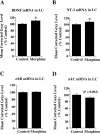Differential regulation of neurotrophin and trk receptor mRNAs in catecholaminergic nuclei during chronic opiate treatment and withdrawal
- PMID: 9852605
- PMCID: PMC6793370
- DOI: 10.1523/JNEUROSCI.18-24-10700.1998
Differential regulation of neurotrophin and trk receptor mRNAs in catecholaminergic nuclei during chronic opiate treatment and withdrawal
Abstract
The neurotrophins brain-derived neurotrophic factor (BDNF) and neurotrophin-3 (NT-3) and their receptors trkB and trkC, respectively, are expressed in the locus coeruleus (LC) and ventral tegmental area (VTA), brain regions known to be involved in opiate addiction. Previously, administration of exogenous neurotrophins has been shown to oppose effects of chronic morphine treatment on LC and VTA neurons. However, the response of endogenous neurotrophins in LC and VTA to opiate treatment is unknown. In this study, BDNF, NT-3, trkB, and trkC mRNAs were analyzed in these regions after chronic morphine treatment and during antagonist precipitated withdrawal. Although chronic morphine exposure resulted in only modest increases in BDNF and NT-3 mRNA expression in LC, precipitated withdrawal led to a marked, rapid, and prolonged increase in BDNF mRNA and a delayed decrease in NT-3 mRNA. Levels of trkB and trkC mRNAs, which were unchanged by chronic morphine treatment, were elevated in LC at 2 and 6 hr of withdrawal. By 20 hr, trkB mRNA levels in LC had returned to control, whereas trkC mRNA levels fell below control values. In contrast to the substantial alterations observed in LC, there was no regulation of the neurotrophins or trk mRNAs within the VTA during chronic opiate treatment or withdrawal, with the exception of an increase in trkB mRNA at 6 hr of withdrawal. These results suggest that neurotrophins and their receptors per se may be involved in opiate-induced plasticity of the LC, whereas other mechanisms would appear to be involved in the VTA.
Figures








Similar articles
-
Differential expression of mRNAs for neurotrophins and their receptors after axotomy of the sciatic nerve.J Cell Biol. 1993 Oct;123(2):455-65. doi: 10.1083/jcb.123.2.455. J Cell Biol. 1993. PMID: 8408225 Free PMC article.
-
Expression of trkB and trkC mRNAs by adult midbrain dopamine neurons: a double-label in situ hybridization study.J Comp Neurol. 1999 Jan 18;403(3):295-308. doi: 10.1002/(sici)1096-9861(19990118)403:3<295::aid-cne2>3.0.co;2-l. J Comp Neurol. 1999. PMID: 9886032
-
Developmental expression of neurotrophins and their receptors in postnatal rat ventral midbrain.J Mol Neurosci. 2005;27(2):245-60. doi: 10.1385/JMN:27:2:245. J Mol Neurosci. 2005. PMID: 16186635
-
[Neurotrophins. I: Molecular features].Rev Med Univ Navarra. 1997 Jul-Sep;41(3):173-9. Rev Med Univ Navarra. 1997. PMID: 10420923 Review. Spanish.
-
The Trk family of neurotrophin receptors.J Neurobiol. 1994 Nov;25(11):1386-403. doi: 10.1002/neu.480251107. J Neurobiol. 1994. PMID: 7852993 Review.
Cited by
-
Ventral Tegmental Area GABA Neurons Are Resistant to GABA(A) Receptor-Mediated Inhibition During Ethanol Withdrawal.Front Neurosci. 2018 Mar 5;12:131. doi: 10.3389/fnins.2018.00131. eCollection 2018. Front Neurosci. 2018. PMID: 29556175 Free PMC article.
-
Norepinephrine Protects against Amyloid-β Toxicity via TrkB.J Alzheimers Dis. 2015;44(1):251-60. doi: 10.3233/JAD-141062. J Alzheimers Dis. 2015. PMID: 25208620 Free PMC article.
-
Elevation of BDNF exon I-specific transcripts in the frontal cortex and midbrain of rat during spontaneous morphine withdrawal is accompanied by enhanced pCreb1 occupancy at the corresponding promoter.Neurochem Res. 2015 Jan;40(1):130-8. doi: 10.1007/s11064-014-1476-y. Epub 2014 Nov 13. Neurochem Res. 2015. PMID: 25392083
-
Expression levels of the BDNF gene and histone modifications around its promoters in the ventral tegmental area and locus ceruleus of rats during forced abstinence from morphine.Neurochem Res. 2012 Jul;37(7):1517-23. doi: 10.1007/s11064-012-0746-9. Epub 2012 Mar 13. Neurochem Res. 2012. PMID: 22410736
-
Opiate-induced molecular and cellular plasticity of ventral tegmental area and locus coeruleus catecholamine neurons.Cold Spring Harb Perspect Med. 2012 Jul;2(7):a012070. doi: 10.1101/cshperspect.a012070. Cold Spring Harb Perspect Med. 2012. PMID: 22762025 Free PMC article. Review.
References
-
- Aghajanian GK. Tolerance of locus coeruleus neurones to morphine and suppression of withdrawal response by clonidine. Nature. 1978;267:186–188. - PubMed
-
- Altar CA, Siuciak JA, Wright P, Ip NY, Lindsay RM, Wiegand SJ. In situ hybridization of trkB and trkC receptor mRNA in rat forebrain and association with high-affinity binding of [125I]BDNF, [125I]NT-4/5 and [125I]NT-3. Eur J Neurosci. 1994;6:1389–1405. - PubMed
-
- Aston-Jones G, Shipley MT, Grzanna R. The locus coeruleus, A5 and A7 noradrenergic cell groups. In: Paxinos G, editor. The rat nervous system, Ed 2. Academic; San Diego: 1995. pp. 183–213.
-
- Berhow MT, Russell DS, Terwilliger RZ, Beitner-Johnson D, Self DW, Lindsay RM, Nestler EJ. Influence of neurotrophic factors on morphine- and cocaine-induced biochemical changes in the mesolimbic dopamine system. Neuroscience. 1995;68:969–979. - PubMed
Publication types
MeSH terms
Substances
Grants and funding
LinkOut - more resources
Full Text Sources
Research Materials
